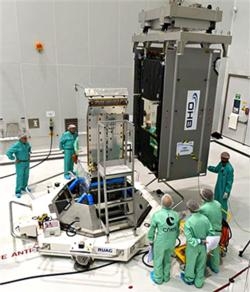Sun, Aug 17, 2014
Two Navigation Satellites To Be Delivered To Orbit August 21
The first of two Galileo navigation satellites to be orbited on Arianespace’s August 21 Soyuz flight has been integrated on its payload dispenser system, marking a key step as preparations advance for this medium-lift mission from French Guiana.

Named “Doresa,” the spacecraft was installed this month during activity inside the Spaceport’s S5A integration hall. It is to be joined on the dispenser system by the mission’s other passenger – “Milena,” whose own installation is forthcoming – in a side-by-side arrangement. The pair then will be mated atop Soyuz’ Fregat upper stage and encapsulated in the protective payload fairing.
“Doresa” and “Milena” – both built by OHB System – are the first FOC (Full Operational Capability) satellites for the Galileo constellation, which will create a European-operated space-based navigation system providing highly accurate, guaranteed global positioning services.
The FOC phase is being funded and executed by the European Union, with the European Space Agency designated as the Galileo system’s development and sourcing agent. The spacecraft payloads, which will generate precision positioning measurements and services to users worldwide, were supplied by Surrey Satellite Technology Ltd. in Guildford, UK.
Designated VS09 in Arianespace’s numbering system, the August 21 flight will be performed from the purpose-built ZLS launch facility for Soyuz – located in the Spaceport’s northern sector near the city of Sinnamary.
Next week’s mission continues Arianespace’s support in the overall Galileo system development. The company’s Starsem affiliate lofted two GIOVE (Galileo In-Orbit Validation Element) satellites in December 2005 and April 2008 on Soyuz missions conducted from Baikonur Cosmodrome in Kazakhstan.
These were followed by four Galileo satellites used for the system’s In-Orbit Validation (IOV) phase, launched in pairs on Soyuz flights performed by Arianespace from French Guiana in October 2011 and October 2012.
(Image provided by Arianespace)
More News
Back-Taxi A term used by air traffic controllers to taxi an aircraft on the runway opposite to the traffic flow. The aircraft may be instructed to back-taxi to the beginning of the>[...]
“Our WAI members across the nation are grateful for the service and sacrifice of the formidable group of WASP who served so honorably during World War II. This group of brave>[...]
“Many aspiring pilots fall short of their goal due to the cost of flight training, so EAA working with the Ray Foundation helps relieve some of the financial pressure and mak>[...]
Blind Speed The rate of departure or closing of a target relative to the radar antenna at which cancellation of the primary radar target by moving target indicator (MTI) circuits i>[...]
Aero Linx: International Airline Medical Association (IAMA) The International Airline Medical Association, formerly known as the Airline Medical Directors Association (AMDA) was fo>[...]
 ANN's Daily Aero-Term (05.19.24): Back-Taxi
ANN's Daily Aero-Term (05.19.24): Back-Taxi Aero-News: Quote of the Day (05.19.24)
Aero-News: Quote of the Day (05.19.24) Aero-News: Quote of the Day (05.20.24)
Aero-News: Quote of the Day (05.20.24) ANN's Daily Aero-Term (05.20.24): Blind Speed
ANN's Daily Aero-Term (05.20.24): Blind Speed ANN's Daily Aero-Linx (05.20.24)
ANN's Daily Aero-Linx (05.20.24)



